Abstract
1. The bronchoconstrictor effects of intravenous administration of adenosine derivatives in anaesthetized non-curarized guinea-pigs have been studied. 2. 2-Chloroadenosine (2-Cl-Ade), 5'-N-ethylcarboxamideadenosine (NECA) and L-N6-phenylisopropyl-adenosine (L-PIA) all produced dose-dependent, transient increases in tracheal insufflation pressure, with an order of potency (NECA greater than or equal to 2-Cl-Ade much greater than L-PIA) typical of A2-receptor mediated biological responses. 3. 2-Chloradenosine-induced bronchoconstrictor responses disappeared after vagotomy or topical application of tetrodotoxin (TTX) on cervical vagal trunks. 4. 2-Chloradenosine-induced bronchospasm was unaffected by atropine (1 mg kg-1 i.v.), physostigmine (50 micrograms kg-1 i.v.) and hexamethonium (30 mg kg-1 i.v.) but was significantly reduced by theophylline (25 mg kg-1 i.v.). 5. The magnitude of 2-Cl-Ade-induced bronchospasm was significantly reduced by acute (10 micrograms kg-1 i.v.) or chronic (55 mgkg-1 s.c. four days before the experiment) pretreatment with capsaicin. 6. Guanethidine (20 mg kg-1 s.c on two consecutive days), prazosin (10 micrograms kg-1 i.v.), diphenhydramine (1 mg kg-1 i.v.) and indomethacin (1 mg kg-1 i.v.) failed to block the bronchomotor response to 2-Cl-Ade. In contrast, cyproheptadine (1-5 mgkg-1 i.v.) markedly reduced, but did not abolish the bronchospasm elicited by the purine derivative. 7. We conclude that in anaesthetized non-curarized guinea-pigs, a transient vagally-mediated bronchospasm can be induced by stimulation of A2-purinoceptors. This effect is complex and involves, at least in part, stimulation of capsaicin-sensitive sensory nerves and 5-hydroxytryptamine release.(ABSTRACT TRUNCATED AT 250 WORDS)
Full text
PDF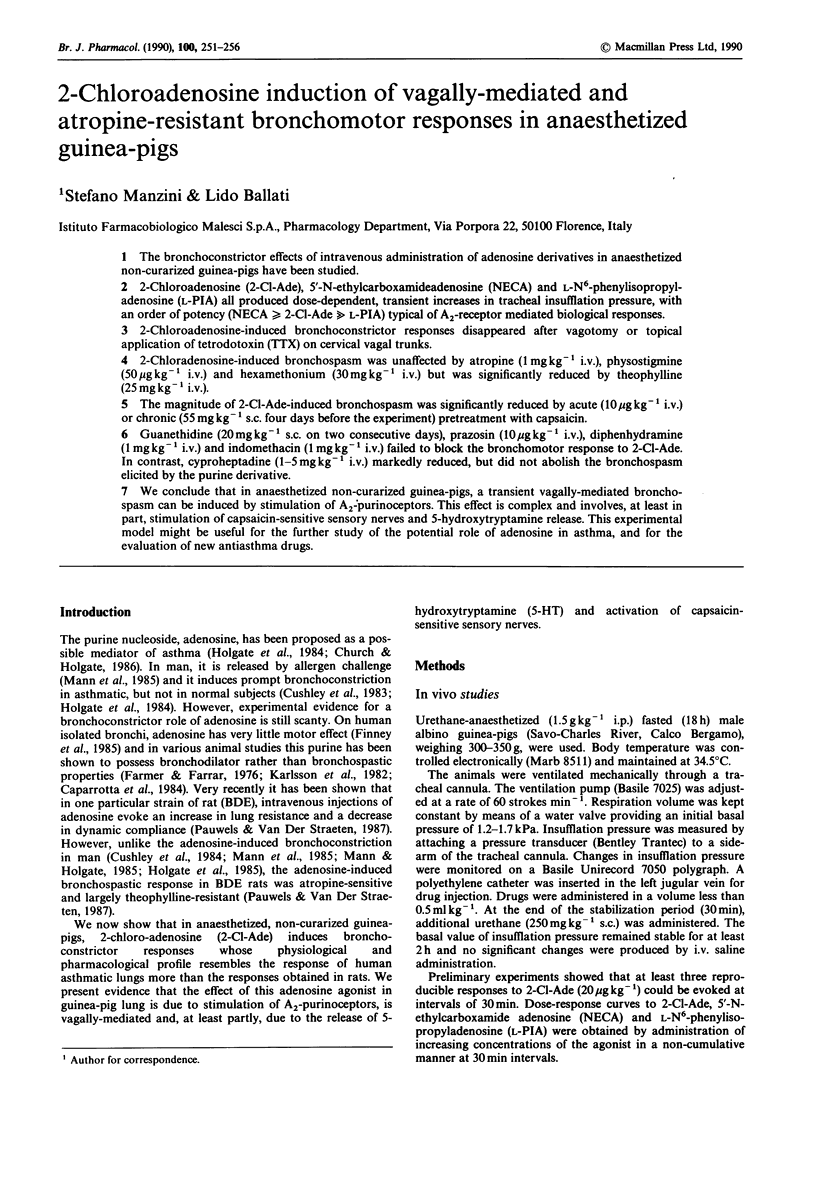
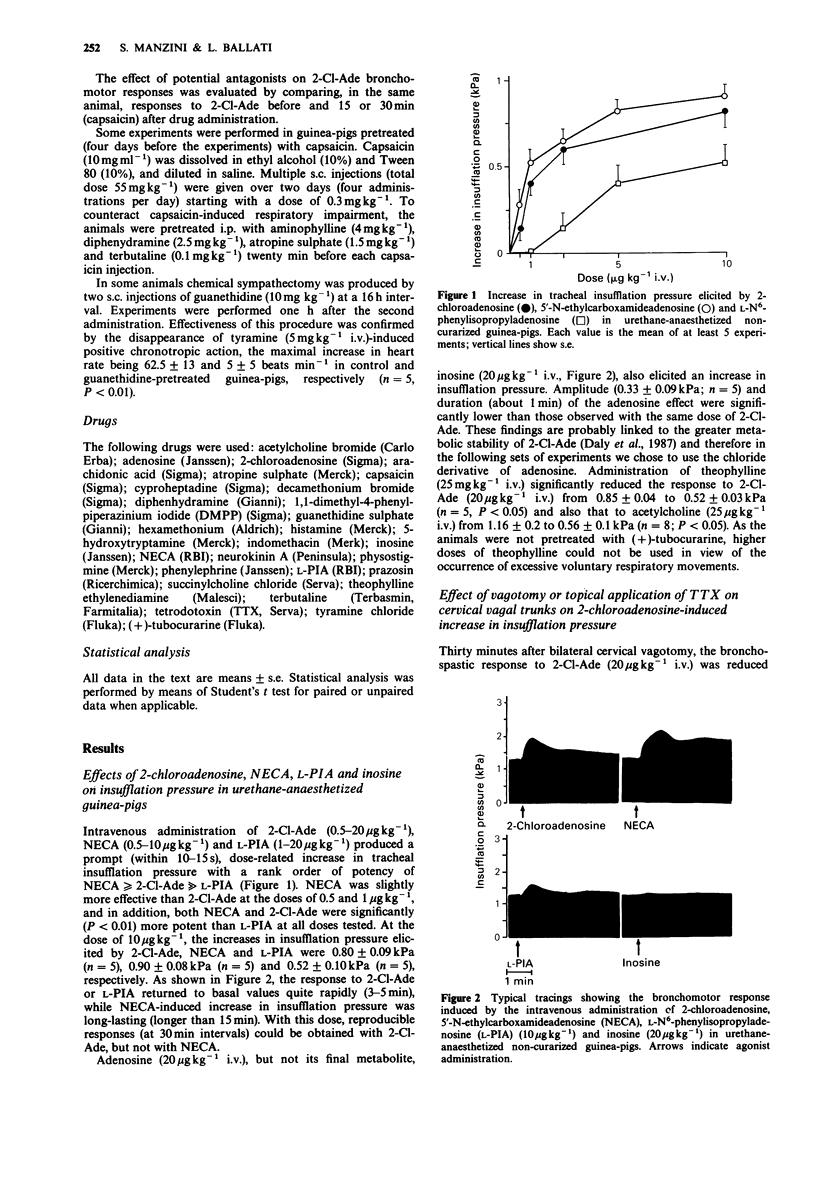

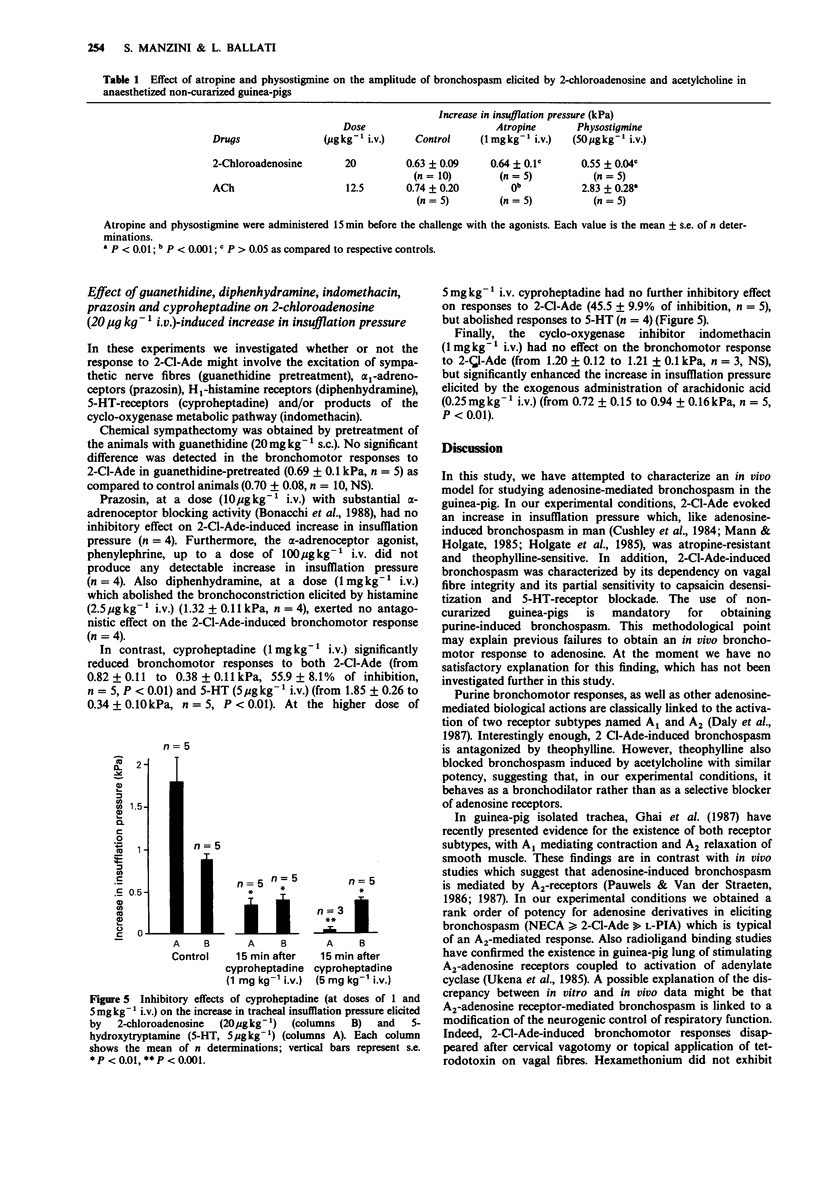
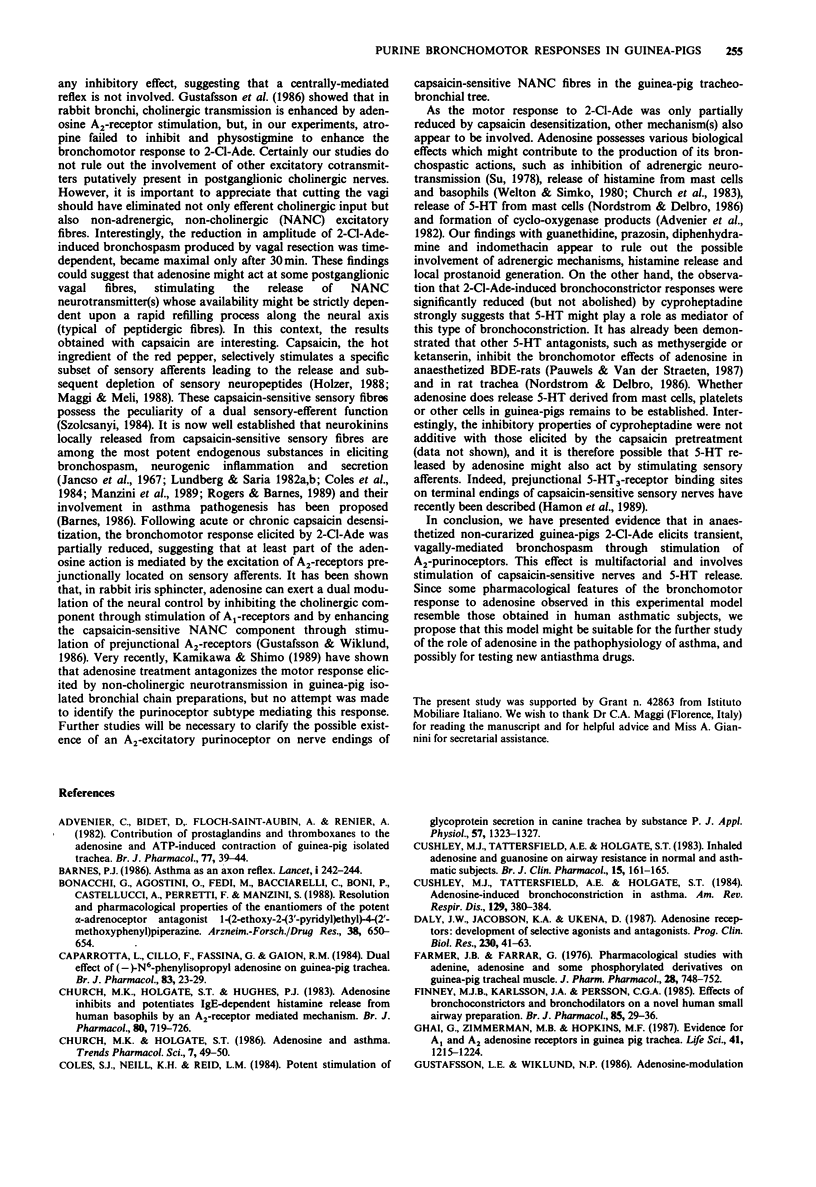
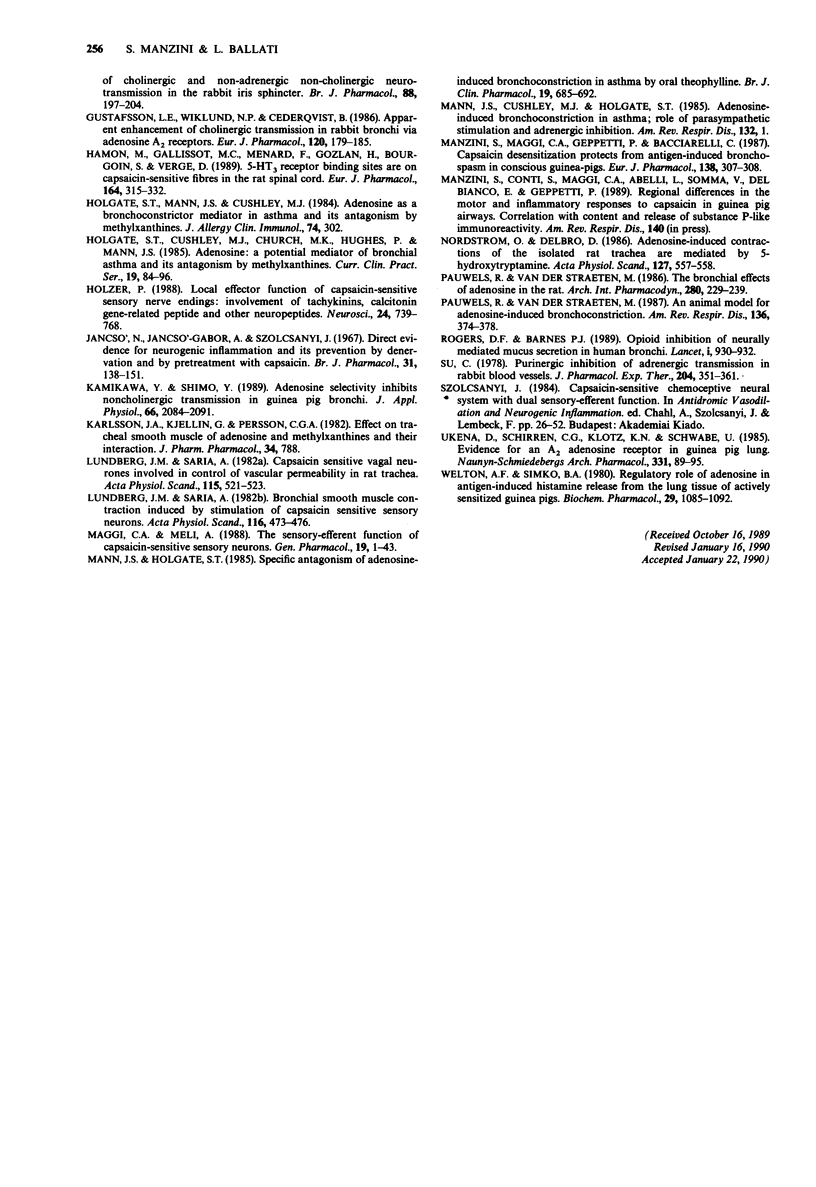
Selected References
These references are in PubMed. This may not be the complete list of references from this article.
- Advenier C., Bidet D., Floch-Saint-Aubin A., Renier A. Contribution of prostaglandins and thromboxanes to the adenosine and ATP-induced contraction of guinea-pig isolated trachea. Br J Pharmacol. 1982 Sep;77(1):39–44. doi: 10.1111/j.1476-5381.1982.tb09266.x. [DOI] [PMC free article] [PubMed] [Google Scholar]
- Barnes P. J. Asthma as an axon reflex. Lancet. 1986 Feb 1;1(8475):242–245. doi: 10.1016/s0140-6736(86)90777-4. [DOI] [PubMed] [Google Scholar]
- Bonacchi G., Agostini O., Fedi M., Bacciarelli C., Boni P., Castellucci A., Perretti F., Manzini S. Resolution and pharmacological properties of the enantiomers of the potent alpha-adrenoceptor antagonist 1-[2-ethoxy-2-(3'-pyridyl)ethyl]-4-(2'-methoxy-phenyl)piperazine. Arzneimittelforschung. 1988 May;38(5):650–654. [PubMed] [Google Scholar]
- Caparrotta L., Cillo F., Fassina G., Gaion R. M. Dual effect of (-)-N6-phenylisopropyl adenosine on guinea-pig trachea. Br J Pharmacol. 1984 Sep;83(1):23–29. doi: 10.1111/j.1476-5381.1984.tb10115.x. [DOI] [PMC free article] [PubMed] [Google Scholar]
- Church M. K., Holgate S. T., Hughes P. J. Adenosine inhibits and potentiates IgE-dependent histamine release from human basophils by an A2-receptor mediated mechanism. Br J Pharmacol. 1983 Dec;80(4):719–726. doi: 10.1111/j.1476-5381.1983.tb10063.x. [DOI] [PMC free article] [PubMed] [Google Scholar]
- Coles S. J., Neill K. H., Reid L. M. Potent stimulation of glycoprotein secretion in canine trachea by substance P. J Appl Physiol Respir Environ Exerc Physiol. 1984 Nov;57(5):1323–1327. doi: 10.1152/jappl.1984.57.5.1323. [DOI] [PubMed] [Google Scholar]
- Cushley M. J., Tattersfield A. E., Holgate S. T. Adenosine-induced bronchoconstriction in asthma. Antagonism by inhaled theophylline. Am Rev Respir Dis. 1984 Mar;129(3):380–384. doi: 10.1164/arrd.1984.129.3.380. [DOI] [PubMed] [Google Scholar]
- Cushley M. J., Tattersfield A. E., Holgate S. T. Inhaled adenosine and guanosine on airway resistance in normal and asthmatic subjects. Br J Clin Pharmacol. 1983 Feb;15(2):161–165. doi: 10.1111/j.1365-2125.1983.tb01481.x. [DOI] [PMC free article] [PubMed] [Google Scholar]
- Daly J. W., Jacobson K. A., Ukena D. Adenosine receptors: development of selective agonists and antagonists. Prog Clin Biol Res. 1987;230:41–63. [PubMed] [Google Scholar]
- Farmer J. B., Farrar D. G. Pharmacological studies with adenine, adenosine and some phosphorylated derivatives on guinea-pig tracheal muscle. J Pharm Pharmacol. 1976 Oct;28(10):748–752. doi: 10.1111/j.2042-7158.1976.tb04040.x. [DOI] [PubMed] [Google Scholar]
- Finney M. J., Karlsson J. A., Persson C. G. Effects of bronchoconstrictors and bronchodilators on a novel human small airway preparation. Br J Pharmacol. 1985 May;85(1):29–36. doi: 10.1111/j.1476-5381.1985.tb08827.x. [DOI] [PMC free article] [PubMed] [Google Scholar]
- Ghai G., Zimmerman M. B., Hopkins M. F. Evidence for A1 and A2 adenosine receptors in guinea pig trachea. Life Sci. 1987 Sep 7;41(10):1215–1224. doi: 10.1016/0024-3205(87)90199-8. [DOI] [PubMed] [Google Scholar]
- Gustafsson L. E., Wiklund N. P. Adenosine-modulation of cholinergic and non-adrenergic non-cholinergic neurotransmission in the rabbit iris sphincter. Br J Pharmacol. 1986 May;88(1):197–204. doi: 10.1111/j.1476-5381.1986.tb09487.x. [DOI] [PMC free article] [PubMed] [Google Scholar]
- Gustafsson L. E., Wiklund N. P., Cederqvist B. Apparent enhancement of cholinergic transmission in rabbit bronchi via adenosine A2 receptors. Eur J Pharmacol. 1986 Jan 21;120(2):179–185. doi: 10.1016/0014-2999(86)90538-8. [DOI] [PubMed] [Google Scholar]
- Hamon M., Gallissot M. C., Menard F., Gozlan H., Bourgoin S., Vergé D. 5-HT3 receptor binding sites are on capsaicin-sensitive fibres in the rat spinal cord. Eur J Pharmacol. 1989 May 19;164(2):315–322. doi: 10.1016/0014-2999(89)90472-x. [DOI] [PubMed] [Google Scholar]
- Holgate S. T., Mann J. S., Cushley M. J. Adenosine as a bronchoconstrictor mediator in asthma and its antagonism by methylxanthines. J Allergy Clin Immunol. 1984 Sep;74(3 Pt 1):302–306. doi: 10.1016/0091-6749(84)90262-8. [DOI] [PubMed] [Google Scholar]
- Holzer P. Local effector functions of capsaicin-sensitive sensory nerve endings: involvement of tachykinins, calcitonin gene-related peptide and other neuropeptides. Neuroscience. 1988 Mar;24(3):739–768. doi: 10.1016/0306-4522(88)90064-4. [DOI] [PubMed] [Google Scholar]
- Jancsó N., Jancsó-Gábor A., Szolcsányi J. Direct evidence for neurogenic inflammation and its prevention by denervation and by pretreatment with capsaicin. Br J Pharmacol Chemother. 1967 Sep;31(1):138–151. doi: 10.1111/j.1476-5381.1967.tb01984.x. [DOI] [PMC free article] [PubMed] [Google Scholar]
- Kamikawa Y., Shimo Y. Adenosine selectively inhibits noncholinergic transmission in guinea pig bronchi. J Appl Physiol (1985) 1989 May;66(5):2084–2091. doi: 10.1152/jappl.1989.66.5.2084. [DOI] [PubMed] [Google Scholar]
- Lundberg J. M., Saria A. Bronchial smooth muscle contraction induced by stimulation of capsaicin-sensitive sensory neurons. Acta Physiol Scand. 1982 Dec;116(4):473–476. doi: 10.1111/j.1748-1716.1982.tb07170.x. [DOI] [PubMed] [Google Scholar]
- Lundberg J. M., Saria A. Capsaicin-sensitive vagal neurons involved in control of vascular permeability in rat trachea. Acta Physiol Scand. 1982 Aug;115(4):521–523. doi: 10.1111/j.1748-1716.1982.tb07116.x. [DOI] [PubMed] [Google Scholar]
- Maggi C. A., Meli A. The sensory-efferent function of capsaicin-sensitive sensory neurons. Gen Pharmacol. 1988;19(1):1–43. doi: 10.1016/0306-3623(88)90002-x. [DOI] [PubMed] [Google Scholar]
- Mann J. S., Cushley M. J., Holgate S. T. Adenosine-induced bronchoconstriction in asthma. Role of parasympathetic stimulation and adrenergic inhibition. Am Rev Respir Dis. 1985 Jul;132(1):1–6. doi: 10.1164/arrd.1985.132.1.1. [DOI] [PubMed] [Google Scholar]
- Mann J. S., Holgate S. T. Specific antagonism of adenosine-induced bronchoconstriction in asthma by oral theophylline. Br J Clin Pharmacol. 1985 May;19(5):685–692. doi: 10.1111/j.1365-2125.1985.tb02696.x. [DOI] [PMC free article] [PubMed] [Google Scholar]
- Manzini S., Maggi C. A., Geppetti P., Bacciarelli C. Capsaicin desensitization protects from antigen-induced bronchospasm in conscious guinea-pigs. Eur J Pharmacol. 1987 Jun 19;138(2):307–308. doi: 10.1016/0014-2999(87)90451-1. [DOI] [PubMed] [Google Scholar]
- Nordström O., Delbro D. Adenosine-induced contractions of the isolated rat trachea are mediated by 5-hydroxytryptamine. Acta Physiol Scand. 1986 Aug;127(4):557–558. doi: 10.1111/j.1748-1716.1986.tb07941.x. [DOI] [PubMed] [Google Scholar]
- Pauwels R. A., Van der Straeten M. E. An animal model for adenosine-induced bronchoconstriction. Am Rev Respir Dis. 1987 Aug;136(2):374–378. doi: 10.1164/ajrccm/136.2.374. [DOI] [PubMed] [Google Scholar]
- Pauwels R., van der Straeten M. The bronchial effects of adenosine in the rat. Arch Int Pharmacodyn Ther. 1986 Apr;280(2 Suppl):229–239. [PubMed] [Google Scholar]
- Rogers D. F., Barnes P. J. Opioid inhibition of neurally mediated mucus secretion in human bronchi. Lancet. 1989 Apr 29;1(8644):930–932. doi: 10.1016/s0140-6736(89)92509-9. [DOI] [PubMed] [Google Scholar]
- Su C. Purinergic inhibition of adrenergic transmission in rabbit blood vessels. J Pharmacol Exp Ther. 1978 Feb;204(2):351–361. [PubMed] [Google Scholar]
- Ukena D., Schirren C. G., Klotz K. N., Schwabe U. Evidence for an A2 adenosine receptor in guinea pig lung. Naunyn Schmiedebergs Arch Pharmacol. 1985 Oct;331(1):89–95. doi: 10.1007/BF00498856. [DOI] [PubMed] [Google Scholar]
- Welton A. F., Simko B. A. Regulatory role of adenosine in antigen-induced histamine release from the lung tissue of actively sensitized guinea pigs. Biochem Pharmacol. 1980 Apr 15;29(8):1085–1092. doi: 10.1016/0006-2952(80)90400-1. [DOI] [PubMed] [Google Scholar]


